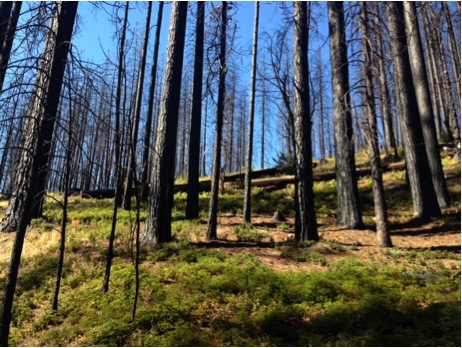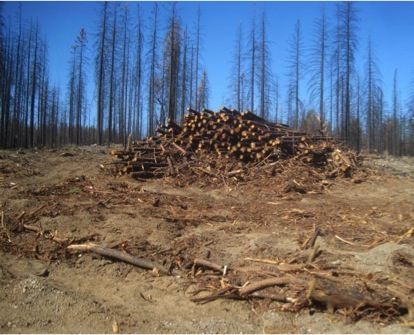Status update for the vast burn area depends on where you look
 Most CSERC members understand that the burned landscape of the 2013 Rim Fire is so vast and so diverse, no single description of its current status is accurate.
Most CSERC members understand that the burned landscape of the 2013 Rim Fire is so vast and so diverse, no single description of its current status is accurate.
In the grass and chaparral areas in low elevations and in the Tuolumne River canyon, re-sprouting vegetation has turned denuded hillsides into mostly healthy early seral stage habitat. In the most extreme high-severity burn areas where conifer forests were incinerated, the lack of surviving cones and seeds means few conifer seedlings are sprouting amidst the groundcovers. Without reforestation, many areas will not be a forest again for perhaps a century, or even longer.
CSERC staff supported hazard tree logging along roads to remove trees that pose risk for public safety. We also strongly supported salvage logging removal of dead trees in areas with the least controversy. The Stanislaus Forest originally put forward a plan to sell 660 million board feet of dead trees. CSERC worked closely with other conservation groups and the timber industry to help craft a scaled back plan that only allowed 210 million board feet to be salvage logged. As a result, most of the steep, most vulnerable hillsides were dropped from logging treatments. An average of 4 large dead trees are being left on each acre. The compromise plan allowed some of the massive amount of dead fuel to be removed while it still had wood value. That meant that taxpayers don’t need to pay to have the fuel removed later.
Nevertheless, despite the consensus-based salvage logging agreement that the Forest Service adopted, three out- of-area environmental organizations sued. Their main claim was that the salvage logging would be negative for the CA spotted owl. CSERC supported the logging project moving forward, pointing out that the Forest Service’s biologists had included a wide range of protective measures, including no logging in Protected Activity Centers and leaving vast burned areas untouched. The court ruled in favor of the Forest Service, agreeing that the agency met all legal requirements.
 Like many environmental issues, however, the on-the-ground reality is not black or white. In areas where hazard trees were removed, vast amounts of non-hazardous small dead trees and dead oaks were also cut down and piled, instead of being left for watershed and wildlife benefits.
Like many environmental issues, however, the on-the-ground reality is not black or white. In areas where hazard trees were removed, vast amounts of non-hazardous small dead trees and dead oaks were also cut down and piled, instead of being left for watershed and wildlife benefits.
Private land salvage treatments stripped almost everything instead of leaving lots of woody material to help hold the soil when storms eventually come. In the areas where Forest Service salvage logging is being done, there are positive fuel reduction benefits and negative soil disturbance impacts. As CSERC has observed, treatments being done in the Rim Fire are a mixture of trade-offs. In upcoming plans for reforestation, there are also likely to be both positive and negative outcomes.

